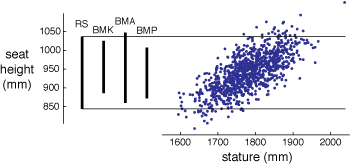In the design of artifacts that interact with people, the spatial dimensions of the target user popula- tion are often used to determine requirements of the engineered artifact. The expected variability in body dimensions (called “anthropometry”) is used to indicate how much adjustability or how many sizes are required to accommodate the intended user population. However, the quantification of anthropometric variability alone is not sufficient to make these kinds of assessments in many situations. For example, two vehicle drivers with similar body dimensions might have different preferred locations for the seat. In these situations, preference can be broken into two components: that explained by body size and the variability that remains. By quantifying the magnitude of both sources, preference can be included in modeling strategies and design decision-making. This improves the accuracy of models and predictions, and can facilitate the application of design automation tools such as optimization and robust design methodologies, resulting in products that are safer, cost effective, and more accessible to broader popu- lations (including people with disabilities). In contrast, failure to include variability in preference that is not attributable to anthropometry can produce misleading results that under- or over-approximate accommodation and prescribe inappropriate amounts of adjustability. A simulation-based approach for modeling both sources of variability and conducting designing for human variability (DfHV) assessments is presented. A stochastic component based on the residual variance in regression analysis relating body dimensions to experimental data is included in the predictive model. This ensures that a distribution of preferred configurations is produced for any given set of body dimensions. The effect of including both components of preference is quantified by comparing this approach to two traditional DfHV approaches in the context of a simple, univariate case study to determine the appropriate allocation of adjustability to achieve a desired accommodation level.
